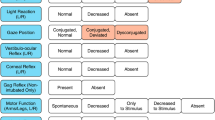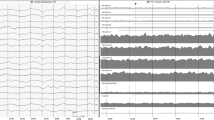Abstract
Objectives: To study value of electroencephalogram (EEG) and computed tomography (CT Scan) in predicting outcome of non-traumatic coma in children.Methods: 100 consecutive children, between 2 months to 12 years, with nontraumatic coma, (Glasgow Coma Scale score <-8). Demographic and clinical data was recorded at admission. EEG and CT scan were done within 24 hours of admission. Etiologic diagnosis was assigned on basis of clinical data and relevant laboratory investigations. The outcome was recorded as survived and died. Among survivors it was graded as no disability, or mild, moderate, or severe disability. Odds ratio and/or relative risk (RR) with 95% confidence interval (CI) were calculated.Results: EEG could be done in 60 patients (43 survived; 7 were normal, 8 had mild, 17 moderate and 11 severe disability) CT scan in 93 patients (60 survived; 11 were normal, 14 had mild, 21 moderate and 14 severe disability). A normal/borderline EEG was associated with good outcome (P = 0.001); 11 of 12 survived and of survivors 55% had no or mild disability. Electrocerebral silence on EEG was a predictor of death (OR = 44; 95% CI -1.5-7372; P =0.01). An abnormal EEG was associated with significant increase in risk of disability among survivors (RR=2.6, 95% CI= 1.2–5.4, P=0.03). Among CT abnormalities intracranial bleed suggested increased risk of death (RR = 2.1; 95% CI-0.8-5.3; P = 0.058), while, hydrocephalus was associated with better survival (RR = 0.7; 95% CI-0.5 to 0.96; P = 0.029). However, hydrocephalus when compared with other abnormal CT scan findings, was associated with higher risk of moderate and severe disability among survivors (P= 0.046)Conclusion: A normal CT scan and EEG, and some of the specific findings could be helpful in predicting outcome in children with non-traumatic coma. EEG and CT scan should be done at admission in all patients with non-traumatic coma if feasible
Similar content being viewed by others
References
Pampiglione G, Harden A. Resuscitation after circulatory arrest: Prognostic evaluation of early electroencephalographic findings.Lancet 1968; 1: 1261–1265.
Biagioni E, Mercuri E, Rutherford M, Cowan F, Azzopardi D, Frisone MFet al. Combined use of electroencephalogram and magnetic resonance imaging in full-term neonates with acute encephalopathy.Pediatrics 2001; 107: 461–468.
Karmel BZ, Gardner JM, Zappulla RA, Magnano CL, Brown EG. Brain-stem auditory evoked responses as indicators of early brain insult.Electroencephalogr Clin Neurophysiol 1988; 71: 429–442.
Rothstein TL. The role of evoked potentials in anoxic-ischemic coma and severe brain trauma.J Clin Neurophysiol 2000; 17: 486–497.
Chen R, Bolton CF, Young B. Prediction of outcome in patients with anoxic coma: a clinical and electrophysiologic study.Crit Care Med 1996; 24: 672–678.
Zandbergen EG, de Haan RJ, Stoutenbeek CP, Koelman JH, Hijdra A. Systematic review of early prediction of poor outcome in anoxic-ischaemic coma.Lancet 1998; 352: 1808–1812.
Carter BG, Taylor A, Butt W. Severe brain injury in children: Long-term outcome and its prediction using somatosensory evoked potentials (SEPs).Intensive Care Med 1999; 25: 722–728.
Ong L, Selladurai BM, Dhillon MK, Atan M, Lye MS. The prognostic value of the Glasgow Coma Scale, hypoxia and computerised tomography in outcome prediction of pediatric head injury.Pediatr Neurosurg 1996; 24: 285–291.
Tasker RC, Matthew DJ, Helms P, Dinwiddie R, Boyd S. Monitoring in non-traumatic coma. Part I: invasive intracranial measurements.Arch Dis Child 1988; 63: 888–894.
Tasker RC, Boyd S, Harden A, Matthew DJ. Monitoring in non-traumatic coma. Part II: electroencephalography.Arch Dis Child 1988; 63: 895–899.
Bansal A, Singhi SC, Singhi P, Khandelwal N, Ramesh S. Nontraumatic coma,Ind J Pediatr 2005; 72: 467–473.
Synek VM. Value of revised EEG coma scale for prognosis after cerebral anoxia and diffuse head injury.Clin Electroencephalogr 1990; 21: 25–30.
Johnston B, Seshia SS. Prediction of outcome in non-traumatic coma in childhood.Acta Neurol Scand 1984; 69: 417–427.
Mewasingh LD, Christophe C, Fonteyne C, Dachy B, Ziereisen F, Christiaens Fet al. Predictive value of electrophysiology in children with hypoxic coma.Pediatr Neurol 2003; 28: 178–183.
Cheliout-Heraut F, Sale-Franque F, Hubert P, Bataille J. Anoxie cérébrale par noyade chez l’enfant: intérêt de l’EEG dans le pronostic.Neurophysiol Clin 1991; 21: 121–132.
Janati A, Erba G. Electroencephalographic correlates of neardrowning encephalopathy in children.Electroencephalogr Clin Neurophysiol 1982; 53: 182–191.
Mandel R, Martinot A, Delepoulle F, Lamblin MD, Laureau E, Vallee L, Leclerc F. Prediction of outcome after hypoxicischemic encephalopathy: A prospective clinical and electrophysiologic study.J Pediatr 2002; 141: 45–50.
Rothstein TL, Thomas EM, Sumi SM. Predicting outcome in hypoxic-ischemic coma: A prospective clinical and electrophysiologic study.Electroencephalogr Clin Neurophysiol 1991; 79: 101–107.
Madl C, Kramer L, Domanovits H, Woolard RH, Gervais H, Gendo Aet al. Improved outcome prediction in unconscious cardiac arrest survivors with sensory evoked potentials compared with clinical assessment.Crit Care Med 2000; 28: 721 -726.
Christophe C, Fonteyne C, Ziereisen F, Christiaens F, Deltenre P, De Maertelaer Vet al. Value of MR imaging of the brain in children with hypoxic coma.Am J Neuroradiol 2002; 23: 716–723.
Tasker RC, Matthew DJ, Kendall B. Computed tomography in the assessment of raised intracranial pressure in non-traumatic coma.Neuropaediatrics 1990; 21: 91–94.
Bohn D. Tools for predicting outcome in the neurologically injured child.Crit Care Med 1993; 21: S332–333.
Author information
Authors and Affiliations
Rights and permissions
About this article
Cite this article
Singhi, P.D., Bansal, A., Ramesh, S. et al. Predictive value of electroencephalography and computed tomography in childhood non-traumatic coma. Indian J Pediatr 72, 475–479 (2005). https://doi.org/10.1007/BF02724423
Issue Date:
DOI: https://doi.org/10.1007/BF02724423




